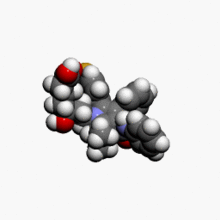Atorvastatin je organsko jedinjenje, koje sadrži 33 atoma ugljenika i ima molekulsku masu od 558,640 Da.[2][3][4][5]
Atorvastatin

|

|
|
|
| Klinički podaci
|
| Robne marke
|
Atogal, Cardyl, Faboxim, Hipolixan
|
| AHFS/Drugs.com
|
Monografija
|
| Identifikatori
|
| CAS broj
|
134523-00-5
|
| ATC kod
|
C10AA05
|
| DrugBank
|
DB01076
|
| KEGG[1]
|
C06834  Y Y
|
| ChEBI
|
CHEBI:2910  Y Y
|
| Hemijski podaci
|
| Formula
|
C33H35FN2O5
|
| Mol. masa
|
558,640
|
| SMILES
|
eMolekuli & PubHem
|
| InChI |
|---|
InChI=1S/C33H35FN2O5/c1-21(2)31-30(33(41)35-25-11-7-4-8-12-25)29(22-9-5-3-6-10-22)32(23-13-15-24(34)16-14-23)36(31)18-17-26(37)19-27(38)20-28(39)40/h3-16,21,26-27,37-38H,17-20H2,1-2H3,(H,35,41)(H,39,40)/t26-,27-/m1/s1
Key: XUKUURHRXDUEBC-KAYWLYCHSA-N  Y Y |
|
| Fizički podaci
|
| Tačka topljenja
|
159.2-160.7 °C (-98 °F)
|
| Farmakokinetički podaci
|
| Poluvreme eliminacije
|
14 h
|
| Izlučivanje
|
Renalno
|
| Farmakoinformacioni podaci
|
| Trudnoća
|
?
|
| Pravni status
|
|
| Način primene
|
Oralno
|
- ↑ Joanne Wixon, Douglas Kell (2000). „Website Review: The Kyoto Encyclopedia of Genes and Genomes — KEGG”. Yeast 17 (1): 48–55. DOI:10.1002/(SICI)1097-0061(200004)17:1<48::AID-YEA2>3.0.CO;2-H.
- ↑ Rouleau J: Improved outcome after acute coronary syndromes with an intensive versus standard lipid-lowering regimen: results from the Pravastatin or Atorvastatin Evaluation and Infection Therapy-Thrombolysis in Myocardial Infarction 22 (PROVE IT-TIMI 22) trial. Am J Med. 2005 Dec;118 Suppl 12A:28-35. PMID 16356805
- ↑ Maggon K: Best-selling human medicines 2002-2004. Drug Discov Today. 2005 Jun 1;10(11):739-42. PMID 15922927
- ↑ Knox C, Law V, Jewison T, Liu P, Ly S, Frolkis A, Pon A, Banco K, Mak C, Neveu V, Djoumbou Y, Eisner R, Guo AC, Wishart DS (2011). „DrugBank 3.0: a comprehensive resource for omics research on drugs”. Nucleic Acids Res. 39 (Database issue): D1035-41. DOI:10.1093/nar/gkq1126. PMC 3013709. PMID 21059682.
- ↑ David S. Wishart, Craig Knox, An Chi Guo, Dean Cheng, Savita Shrivastava, Dan Tzur, Bijaya Gautam, and Murtaza Hassanali (2008). „DrugBank: a knowledgebase for drugs, drug actions and drug targets”. Nucleic Acids Res 36 (Database issue): D901-6. DOI:10.1093/nar/gkm958. PMC 2238889. PMID 18048412.
- ↑ Ghose, A.K., Viswanadhan V.N., and Wendoloski, J.J. (1998). „Prediction of Hydrophobic (Lipophilic) Properties of Small Organic Molecules Using Fragment Methods: An Analysis of AlogP and CLogP Methods”. J. Phys. Chem. A 102: 3762-3772. DOI:10.1021/jp980230o.
- ↑ Tetko IV, Tanchuk VY, Kasheva TN, Villa AE. (2001). „Estimation of Aqueous Solubility of Chemical Compounds Using E-State Indices”. Chem Inf. Comput. Sci. 41: 1488-1493. DOI:10.1021/ci000392t. PMID 11749573.
- ↑ Ertl P., Rohde B., Selzer P. (2000). „Fast calculation of molecular polar surface area as a sum of fragment based contributions and its application to the prediction of drug transport properties”. J. Med. Chem. 43: 3714-3717. DOI:10.1021/jm000942e. PMID 11020286.
Literatura
uredi
Spoljašnje veze
uredi

